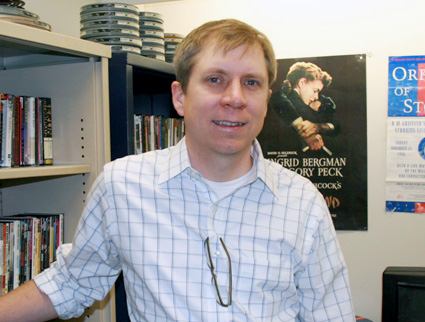Composed of a diverse array of faculty, staff and administrators, the Oakland University community is unique, creative, and dedicated. As part of a continuing effort to explore the various roles and lives of our Golden Grizzlies, the News @ OU website presents a new interview series. We invite you to share these stories and “Take 5” with OU.
"Take 5 with Kyle Edwards"
Kyle Edwards is the director of the Cinema Studies Program and assistant professor of English. In his time at OU, Kyle has worked to develop what was once only a film concentration into the full-blown major it is today. Only a few years old, the program is growing rapidly, allowing Kyle to build new curriculum and offer courses in his specialties, such as film adaptation, cultural and film theory, focused courses on individual movie stars of the thirties and forties, and American independent cinema. A native of California, Kyle moved to Michigan for his Oakland position, in 2006.
1) Why is Cinema Studies something we should invest in now?
Cinema history is an important link to our collective past. It allows us to understand social and cultural elements in the United States and across the world in a way unlike any other. Not only students, but every one gets a great understanding of our own history. Here, our students begin to think critically about the things they see in life. By watching films, they can glean the explicit and implicit messages that films send. And by extension, they can discern the messages and meanings behind the whole barrage of images that we are faced with today. From advertisements and social media to youtube and the media, students can become competent consumers and creators of culture. Through technology, we communicate with each other to a visual degree more now than in the past. Students can literally shoot a film on their cell phone and upload it as a complete piece to youtube within a very short time frame. Our classes combine creative theory and practice, which builds a well-rounded skill set for our students.
2) What are some of your favorite films or genres of film?
My favorite film of all time is “Bringing Up Baby,” a screwball comedy from the thirties with Katherine Hepburn and Cary Grant. The first time I saw it was in a revival theater, which is a great setting for watching older films. The comic cues are a little different and it is wonderful to view it in a theater. I really like the melodramas of the thirties and forties, the “weepies,” they used to be called. Whenever I show this kind of film in class, such as “Stella Dallas,” with Barbara Stanwyck, I get a very divided response from students. On the contemporary side, Wes Anderson is a director I keep coming back to.
3) Where would you like to see the Cinema Studies program in the next five years? Ten years?
That is exactly what we are trying to figure out. We still have a very small core of faculty, and are looking to expand that. We would like to move the Cinema Studies program into a more production-based set of courses. We can collaborate a lot with the English Department, and link with the creative writing majors for courses in screenwriting and such. We are also continuing to build on professional opportunities for our students, and to integrate real film production work into the curriculum more. We already have a partnership with filmmaker Michael Manasseri, allowing our students to work as interns on his film sets, something that makes our program really unique. We offer our students a real-world, professional training opportunity that gives them an in-depth look into the film industry. Students get an academic experience here that they can’t get anywhere else. And we have lots of ideas for the future.
4) What qualities does an ideal film student have?
From my perspective, it is most important to have a passion for film, as a film critic or a filmmaker or both. They must have an interest in thinking critically about film and truly care about the medium. But our students need to challenge themselves to examine films on their own and to make films by themselves. They need to be willing to work hard for projects both in class and independently. If you want to be in the industry, the work never stops and you really need to believe in yourself and put your own ideas and time on the line. I also like to encourage students to work collaboratively and participate in organizations like Student Video Productions or the Film Guild at OU. Collaboration is something students need to experiences, particularly with film, as so much of creating a film relies on the nuances of working with others.
5) What is something everyone (family/ friends) knows about you?
For a long time I was a collector of baseball cards and movie memorabilia. I still collect novelizations, which is when a movie is adapted into a book as part of a film’s marketing. Sometimes I bring those books to class and they are always interesting. Whenever I’m in a used book store, I always look out for novelizations, especially for those that don’t seem conducive to novelizing. I have one of “Grease,” and another of “Mary Shelly’s Frankenstein,” which was a book that was adapted into a movie, and then turned into a new book.

